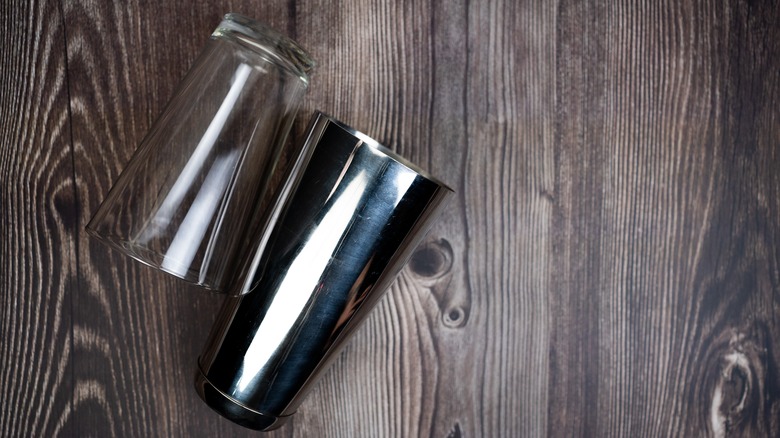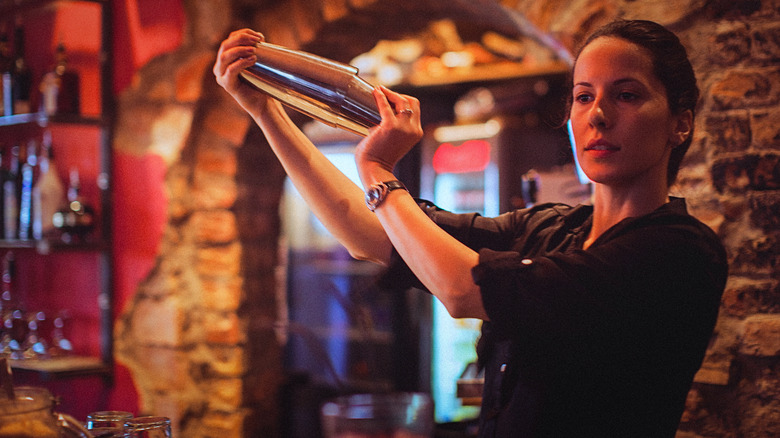The Wrong Way To Shake A Cocktail, And How To Correct Yourself
In The Thin Man, a Golden Age Hollywood classic featuring Nick and Nora Charles as husband and wife detectives, cocktail shaking is associated with tempo. "The important thing is the rhythm. Always have rhythm in your shaking," Nick tells a group of assembled bartenders during the film's opening moments (via YouTube). It's a memorable scene, but as a teaching tool, it's a fizzle. Tempo, it turns out, has almost nothing to do with proper cocktail-making technique.
Timing does matter. Shake drinks vigorously for 12 seconds or more with any tempo or technique, and they'll end up in a similarly frosty state, with comparable levels of dilution. That's not to say, however, that there isn't a right and wrong way to wield a cocktail shaker. As the Diageo Bar Academy notes, horizontal shaking motions are the preferred method. Why? The goal is to break down the ice, a process good bartenders can feel happening as they manipulate the shaker in a two-hand, back-and-forth motion over their shoulders.
The ice won't break down efficiently using a vertical shaking motion, as it won't be exposed to as much surface area in the metal shaker. So despite the many ways you may see bartenders shaking cocktails, the proper method is the over-the-shoulder technique. Home bartenders should also avoid overshaking, which can lead to too much drink dilution. Use a slow 10 count. At 15 seconds, you've probably shaken too much.
Mistakes to avoid when shaking cocktails
Horizontal shaking motions are optimal, but that's not the only reason to use the over-the-shoulder shake. This method can also keep you from spritzing house guests or paying customers in the event of a loose seal. This assumes, of course, that you're using the traditional Boston shaker with a pint glass, the combo used by most professional bartenders. There are other shaker types common in home bars, however, including the Cobbler shaker, which has a screw-on strainer top and removable cap. It's a great mistake-free option for beginners.
Professional bartenders prefer the Boston shaker with a pint glass and Hawthorne strainer set-up because it's faster. When making the drink, pour the ingredients into the pint glass, adding ice last. Pop the Boston shaker on for a tight seal, but keep the pint glass on top, or in the back, as you shake, so if the seal loosens you won't spray cocktail liquid on anyone. This is particularly embarrassing with drinks that include cranberry juice or grenadine.
A good seal is essential, but some beginners worry about getting the two pieces stuck. To properly break the seal, pop the shaker with the palm of your hand above the seal line. Do not hit the shaker against the bar to unlock the seal. This is a good way to break the pint glass and spend a lot of time trying to clean shards of glass out of your ice well.
Advanced shaking techniques for cocktails with egg whites
Not every cocktail is meant to be shaken, despite the frequent protests to this effect by another cinematic character: British spy James Bond. This is an important note because drinks are generally classified as shake or stir-worthy based on their ingredients, and some ingredients — like egg whites — may require different techniques when shaken. Egg whites, for example, are best handled with a dry shake technique, meaning without ice in the shaker. They also require a longer shake period.
Henry Charles Ramos, inventor of the Ramos gin fizz, used to ask his bartenders to shake for an arm-wearying 12 minutes. Nowadays, however, a 30-second dry shake is enough to integrate the egg whites with other cocktail ingredients and to give them their signature frothy texture. A reverse dry shake, a variation in which the other ingredients are shaken and strained separately before a dry shake with the egg whites, is often recommended for cocktails like the Ramos gin fizz and whiskey sour.
Which cocktails should be shaken, and which stirred? Drinks with lemon or lime juice, cream, or egg whites, should properly be shaken. Just remember to use two hands – at least with a Boston shaker — and maintain a horizontal motion when shaking.



